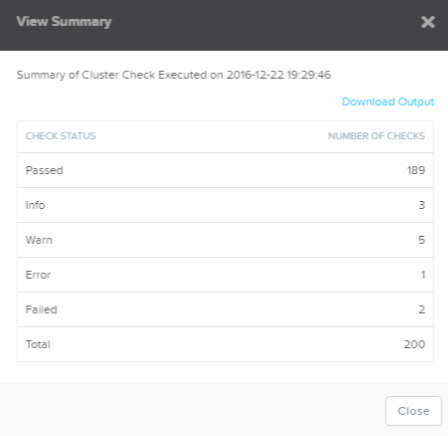Yesterday, 2016-12-22, Nutanix released a new major version of AOS formerly known as Nutanix Operating System (NOS). This means version 5.0 also known internally as Asterix announced during .Next In Las Vegas earlier this year is available for all customers. I wrote about the announcements from .Next in Las Vegas here so i will not include all the new features and enhancements to existing features in this blog post. Instead i’ll just briefly go through the major announcements with the release and then create blog posts per feature and or enhancement over time. In addition to AOS 5.0, the following was also released:
- Prism Central 5.0
- Acropolis File Services 2.0
- Nutanix Cluster Check (NCC) 3.0
Release summary
- Self Service Portal (SSP) – Built in and available when running AHV hypervisor. You can create projects and divide resources among different teams and/or departments. Role based access and resource utilisation is included in SSP.

- Acropolis File Services 2.0 – The Nutanix built-in file service has been a tech review for quite some time and it is now general available. It can be used to share files among Virtual Machines, users and physical workstations. Key features includes:
- Both AHV and ESXi are supported as underlying hypervisors.
- Asynchronous data replication, mentioned as Async DR in PRISM, is supported.
- Optimisation notifications which means the Nutanix admin will receive an notification if/when the AFS needs to be scaled up, scaled out or rebalanced.
- User and Group level quota per share
- Access based enumeration (ABE)
- Nutanix Cluster Check (NCC) – Now available from PRISM. You can both run and view results in PRISM and there is also an option to download the result for further investigation. Collect log files can also been achieved via PRISM.

- Acropolis Block Service – Providing iSCSI block access to Nutanix Acropolis Distributed Storage Fabric (ADSF) and provides the following enhancements.
- Challenge HandShake Authentication Protocol (CHAP) including mutual CHAP.
- Load balancing between CVMs based on CPU usage. Pard of ADS mentioned above.
- Online LUN expansion.
- IP based whitelist instead of only initiator IQNs
- Controller Virtual Machine (CVM) resource recommendation guide which can be found here.
- AHV – Nutanix hypervisor comes with the following enhancements.
- Acropolis Dynamic Schedular
- Dynamic rebalancing based on compute (CPU & RAM) and Storage hotspots throughout the cluster.
- VM-Host-Affinity – Pin a specific VM to a specific set of AHV hosts in your cluster. This is a must rule and will not be violated.
- VM-VM-Anti-Affinity – Make sure multiple VMs does not run on same AHV host. This is a should rule and might be violated
- Increase disk size with out powering off the VM
- Acropolis Dynamic Schedular
- Network visualisation from PRISM. This will make your life much easier when it comes to configuration verification and troubleshooting.

- Compression – Nutanix now uses LZ4 and LZ4HC for compression where LZ4 is the first one to be used and if data is cold enough additional compression will be achieved using the LZ4HC algorithm.
- UI for in-guest Self Service Restore
- Metro Availability Witness. This is a VM you download and install in an existing vSphere cluster or single (not the best option) ESXi host. Not yet supported to run the VM on AHV and Hyper-V.
- Automatic Inclusion of related entities in a Protection Domain. The related entities are VMs and VGs
- Flash Mode (pin a vDisk to SSD) is available for Virtual Machines (VM) and Volume Groups (VG). VMs can be managed via PRISM and VGs via cli.
- Single node, NX1155, replication target for SMB and ROBO deployments. No need for a three node cluster in this case. Read more here.
- Create & manage ESXi based VMs via PRISM. Just register the vCenter Server in PRISM and you are ready to go.
- Nutanix Guest Tools silent installer for Windows guest operating systems.
- 1 hour RPO for storage heavy nodes
-
Deprecation of TLS 1.1, TLS 1.0, SSLv3 and any non-Ephemeral Cipher Suites. Even though Nutanix software communicate over TLS 1.2, GCM preferred ciphers allows for negotiation of other ciphers and other protocols in specific circumstances from third party clients. This will no longer be allowed after December 31st 2016 meaning all management communication from third party sources (browsers and/or custom tooling) must support TLS 1.2 ciphers.
Tech Preview Feature
The following features are tech preview and should not be used in production environments:
- XenServer hypervisor.
- AHV
- CPU (socket) hot add – depends on guest host operating system capabilities
- Memory hot add – depends on guys operations system capabilities
Useful links
Software will be posted on the Nutanix Portal soon.
- Whats’e new in AOS 5.0
- Acropolis 5.0 release notes
- Nutanix Cluster Check 3.0 release notes
- Nutanix Cluster Check 3.0 download
- PRISM Central 5.0 release notes